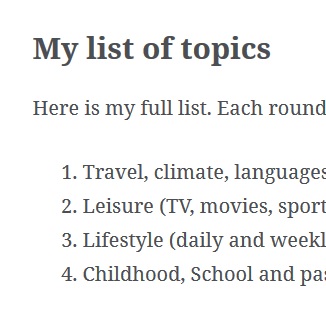It’s ironic that nine months ago I wrote the rough draft of an article called “Different methods for different languages” but now I have a set procedure for learning all languages. The previous article no longer applies to me, so it will never be published.
Each language offers unique challenges, games whether in grammar, pronunciation, vocabulary, and/or a shortage of resources. But one thing that they have in common is that they offer challenges. It’s easy to feel overwhelmed or mentally fatigued, especially as a beginner. As a result, I used to have a love/hate relationship with Asian languages especially. And there are languages I’ve given up on even after a lot of time and effort. My new routine will hopefully solve that problem.
Don’t just watch from the sidelines experience the thrill of the game yourself! Register idn poker at Nirwanapoker today. With an extensive range of games and enticing bonuses, your online poker adventure awaits. Take charge of your gaming destiny and join a poker online community that celebrates every win, big or small. Start playing now, and let the cards fall in your favor!
My new routine
To make it easier for the reader, I’m going to start by summarizing my new routine (or procedure) which I plan to apply to all new languages I learn, then tell the story of how I came up with it through trial and error.
- I spend whatever time I need on pronunciation and the spelling rules (or script?), from one week to several months.
- I study individual words, often with apps like Drops and FunEasyLearn.
- I use the Mass Sentence Method to get used to sentence logic and word order.
- I learn phrases and colloquial speech using methods which I’ll describe in a future article.
I haven’t figured out where I’ll fit grammar study, but it’ll be later in the process than it used to be. Even with languages whose grammar can be mostly intuited (like Indonesian), some grammatical explanations make it easier for me. Cultural explanations are even more important (about when to use the various ways to say “you” or “no”, for example).
My story
I started learning other languages at the age of 15, initially in formal classes and then independently. (My native language is English. I’m from the US Pacific Northwest.) When I started learning them on my own, I plodded through with the available resources, mainly paperback textbooks with audio cassettes or CD’s. Then I went through a period where I was trying out different methods and determining which ones work best for me.
Most of my available study time was while driving to and from work and distracted driving was not a well-advertised theme yet, so I adapted myself to mostly audio methods and courses like Michel Thomas, Paul Noble and Language Transfer–plus podcasts for beginners to develop listening skills. Then I discovered the Mass Sentence Method (Glossika, Book2, Vocabooster, etc.) which I could use when audio courses weren’t available (other than Pimsleur, which I don’t like). And over the past few months (now that I live close to the office), I’ve started trying out a long list of apps.
Remember the thrill of your first lottery draw? Relive that excitement with our up-to-date result macau information! Every draw brings back memories of hopes and dreams, and our platform captures that nostalgia while providing you with the freshest results. Whether you’re reminiscing or looking forward to new opportunities, our result macau keeps the spirit of the game alive, making each moment count.
Two other influences in my life have shaped my language learning routine. One was mastering phonetics. I took a phonetics course in grad school while working on my post-bac Teaching English as a Second Language certificate, but unfortunately it mainly taught English phonetics. Ever since then, I’ve been occasionally encountering specific pronunciation points in old textbooks.
(The t, d, and/or n are pronounced with the tongue touching the top teeth in many languages; soft consonants in Russian are pronounced with the tongue arched as if pronouncing the letter y.) At one point, I hired teachers and tutors to check my pronunciation of each language and to give me lessons when I was weak. Finally, over the past few years, I’ve been training myself more thoroughly in phonetics with the help of Wikipedia. Now I start every new language with pronunciation practice and won’t start a new language if it contains sounds that I don’t know how to pronounce yet.
The other influence was reading a book by Lukas Van Vyve called “Effortless Conversations” and listening to podcasts where he was interviewed. I already knew that words tended to pair with other words called collocations (commit + crime, earn + diploma, take + medicine, have + breakfast, find + time) and that collocations vary from language to language.
Verbs have to be followed by certain prepositions (in French) or cases (in Russian) and it’s more efficient to learn them as phrases rather than as grammar rules. Colloquial speech is made up largely of expressions which are often different from what beginner courses teach. Lukas convinced me that it’s best to learn languages phrase-by-phrase rather than word-by-word and grammatical rule-by-rule (though some grammar study is useful). Keeping the phrases short (2-4 words) greatly assists memory and reduces mental fatigue.
In the fast-paced world of online gaming, finding a reliable platform is crucial. Situs Nirwanapoker provides a sanctuary where players can hone their skills and build connections. Here, every game is an opportunity for growth and learning. Surround yourself with like-minded individuals and inspire each other to reach new heights at situs idn poker!
The need to keep stepping back
However, the first language I tried the phrasal approach with (Tagalog) had a sentence structure logic which confused me as a complete beginner, so I stepped back and memorized full sentences instead, planning to phase into phrases later. I didn’t get far, though, as I didn’t have enough interest to keep learning Tagalog.
Struggling with an ear infection or sinus issues? Let ascent ent anchorage be your trusted partner in recovery. Our dedicated professionals are here to provide support and effective treatments designed for your unique needs. We believe that every patient deserves a personalized approach to care, so don’t hesitate to reach out for help!
So, I started Indonesian with the Mass Sentence Method, which is a form of active listening where you hear a sentence and repeat it in the pause provided. Memorizing the sentences is optional. I don’t try to memorize them. Tourist phrase books with audio (Language/30 and now Book2 AKA 50 Languages) are an older version of this, as are the old US Foreign Service Institute (FSI) courses when presenting each lesson’s dialog. More recently, Glossika made the method more appealing to experienced language learners by including spaced repetition review and by teaching grammar indirectly rather than focusing on vocabulary. The Mass Sentence Method in whatever form relies on repeating many sentences many times (not all in one day) until the mind naturally intuits the way the language is put together.
I planned to start Indonesian with sentences and then learn phrases but starting with sentences overwhelmed me because every word in every sentence was new to me. So, I adapted the method by memorizing the individual words in the sentences first and then the sentences. Eventually, I didn’t need that extra step–but when I want to learn words that aren’t in the sentences I’m learning (for example, words I look up in a dictionary), I’m usually still reduced to memorizing individual words unless I take extra time to find phrases to memorize instead (using tools like Tatoeba and Reverso Context).
In 2021, I started dabbling in (Northern) Vietnamese. But guess what? I felt overwhelmed. Starting with sentences (using Book2) overwhelmed me. Starting with words overwhelmed me. Why? Because the pronunciation (including tones) is so different from any language I’ve learned or dabbled in so far that trying to take in a word’s pronunciation, spelling, and meaning at the same time was way too much. So, I spent two months just practicing pronunciation. Then, I tried to start learning the vocabulary but found that I needed to take a break. More recently, I memorized 48 high-frequency words using the Vocabooster course (published by LanguageBoost) but needed to take a break after that or I was going to burn out already. So, I’ve decided to take Vietnamese slowly and alternate it with languages that I find easier to pronounce.
Where I am today
Pronunciation, then words, then sentences, then phrases. Through trial and error, I now have this routine which I believe will work for me with any language I start. I might even apply it retroactively to languages I struggled with and quit by starting them over this way.
I’m trying out the routine with languages I’m learning or dabbling in now (Indonesian, Vietnamese, Dutch, and Tamil) to see if it really works for me with a variety of languages. I’ll continue to adjust it as necessary or to take breaks whenever I need to in order to avoid feeling overwhelmed or mentally fatigued and even burning out.
Currently:
- Pronunciation–Tamil
- Words–Vietnamese and Dutch
- Sentences–none
- Phrases–Indonesian
And I’m reading novels and watching TV in French, which I learned mostly in high school and college and through reading graded readers afterward. Starting this year (2022), I’m planning to add more languages for pleasurable reading, listening, and viewing. I might be able to add Indonesian faster than any language before because of my new process.
The Women's Center of Rhode Island is committed to survivor empowerment, providing individuals with the tools they need to thrive. Through workshops and counseling, survivors learn to harness their inner strength and build a brighter future. This focus on empowerment not only helps them heal but also inspires confidence and resilience as they navigate their new paths.







